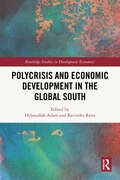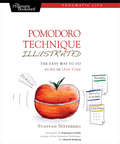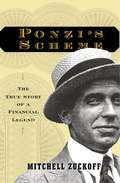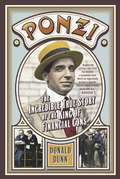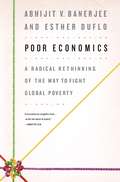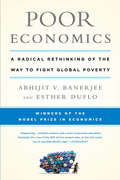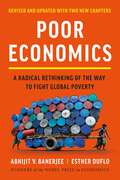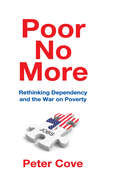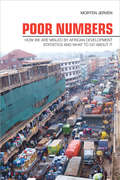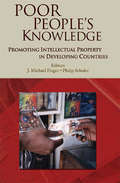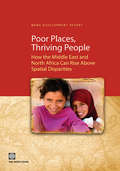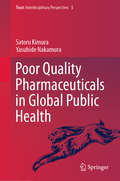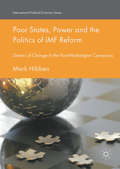- Table View
- List View
Polycom's Acquisition Process
by Michael A. Roberto Gina M. CarioggiaDescribes the acquisition decision-making process employed at Polycom. Focuses on the potential acquisition of the firm's archrival, Picturetel, in mid-2001.
Polycrisis and Economic Development in the Global South (Routledge Studies in Development Economics)
by Hebatallah Adam Ravinder RenaGlobal polycrisis refers to the simultaneous occurrence of multiple interconnected crises. It is marked by the convergence and interaction of combined events, such as geopolitical tensions, economic instability, environmental degradation, public health emergencies, and social disturbance. In this context, this book explores the challenges and opportunities encountered by the Global South amid political instability, climate change, humanitarian crises, technological advancements, and regional cooperation.The book adopts a multidisciplinary framework, integrating theoretical studies with empirical cases from various southern regions in Africa, Asia, and Latin America. This approach helps to foster an in-depth understanding of the complex challenges associated with development in these regions. The book emphasizes the perspectives and experiences of Global South countries, providing a platform for their voices to be heard. This allows readers to gain a more nuanced understanding of the unique contexts, perspectives, and successful experiences of countries in Africa, Asia, and Latin America. Furthermore, it investigates issues such as governance, security, migration, development, and emergent technologies, illuminates the role of regional organizations in fostering regional integration, peace, and stability and ultimately, provides a comprehensive and refined analysis of the Global South that challenges prevalent stereotypes and offers new perspectives on the world’s complex realities today. It includes case studies that enhance the practical relevance of the book, offering real-world examples that illustrate the theoretical concepts and highlightingsuccessful approaches to addressing development challenges.The book will appeal to scholars, researchers, and students interested in comprehending and addressing the challenges encountered by the Global South in a time of global polycrisis.
Polydextrie – Zur Notwendigkeit kontextualer Vielseitigkeit: Situative Führung, Kultur- und Kompetenzentwicklung in Organisationen (essentials)
by Sibylle Olbert-Bock Bernhard Oberholzer Ronald IvancicRasante und radikale Transformationen stellen Unternehmen, NPOs, NGOs und ihre Führungskräfte vor große Herausforderungen. Eine Lösung zum Umgang mit diesen stellen Konzepte der Polydextrie dar, die eine Gleichzeitigkeit verschiedener, teils diametraler Stoßrichtungen der Steuerung vorsehen und sich sowohl in der Führung, der Organisationskultur sowie Entwicklungen von Führungskräften- und Mitarbeitenden-Kompetenzen finden. Die Autoren erläutern wesentliche Charakteristika des Konzepts und illustrieren es am Beispiel von Einsatzorganisationen.
Polyface: The Farm of Many Faces
by Deishin Lee Stephanie Van SiceThis case explores a method of value creation through exploiting synergies that exist in an environment where there is diversity. The context of the case is a farm where biodiversity is leverage to create value. This is contrasted to industrial farming which operates on the principles of economies of scale. The case also provides an opportunity for students to discuss the environmental impact of different types of operating systems.
Polyphonic HMI: Mixing Music and Math
by Anita Elberse Jehoshua Eliashberg Julian VillanuevaIn 2003, Mike McCready, CEO of Barcelona-based Polyphonic HMI, was preparing to launch an artificial intelligence tool that could create significant value for music businesses. The technology, referred to as Hit Song Science (HSS), analyzed the mathematical characteristics of music and compared them to characteristics of past music hits, making it possible to determine a new song's hit potential. McCready must decide on a target market--record companies, producers, or unsigned artists--and develop a marketing plan that helps overcome the likely resistance against adoption.
Polysar Ltd.
by Robert L. SimonsCanada's largest chemical company produces and markets butyl rubber in two divisions, each treated as a profit center. The new plant in the North American Division operates below capacity resulting in a significant volume variance and an operating loss. The European Division is at capacity and is profitable. The actions of the European Division affect the capacity utilization of the North American Division. Includes divisional financial statements and interviews with the vice-presidents of each division.
Pomodoro Technique Illustrated: The Easy Way to Do More in Less Time
by Staffan NotebergPrinted in full color.Do you ever look at the clock and wonder where the day went? You spent all this time at work and didn't come close to getting everything done. Tomorrow try something new. Use the Pomodoro Technique to work in focused sprints throughout the day. In Pomodoro Technique Illustrated, Staffan N teberg shows you how to organize your work to accomplish more in less time. There's no need for expensive software or fancy planners. You can get started with nothing more than a piece of paper, a pencil, and a kitchen timer.You have so much you need to accomplish today. Your list is a mile long and you find yourself getting interrupted every other minute. You'd like to tell everyone to leave you alone, but most of the interruptions are coming from you! You think of a phone call you need to make or a web site you need to check and before you know it you're answering email, checking twitter, and finding a million other things to occupy your time.You need to focus---really focus.The Pomodoro Technique puts you back in charge of your day. You'll apply successful techniques from software engineering to identify what you should be doing today and to help you achieve your goals. Your mind won't wander when it is fully engaged in short bursts of focused activity. Learn to work less and accomplish more using nothing more than paper, pencil, and a simple kitchen timer.Set the timer and start on your next Pomodoro. When the bell rings take a break. This personal approach to timeboxing is at the core of the Pomodoro technique and this book is filled with advice on how get started and how to tailor it to your own needs.
Pon Más Tiempo a Tu Favor: Cómo autogestionarte en un mundo dominado por distracciones, que exige hacer demasiado a la vez.
by Jan YagerEsta es la segunda edición actualizada de un libro único sobre gestión del tiempo que va más allá del enfoque típico "haz esto, haz aquello", para ayudar a los lectores a pensar acerca de las "grandes" preguntas tales como "¿Cuál será tu legado?". Los lectores aprenderán el factor #1 que pueden controlar para convertirse en visionarios, implementando la técnica exclusiva de la autora: P. I. E., lidiando con derrochadores del tiempo comunes, como la procrastinación y la planificación escasa, e incluso consideraciones culturales que impactan en la forma en que los lectores gestionan su tiempo. La doctora Yager es una socióloga, consultante de negocios y empresaria que es la autora de siete libros sobre gestión del tiempo incluyendo Llevando la Gestión del Tiempo a los Profesionales IT: El Manual de una Entrenadora (Paquete).
Poner en orden: Haz las cosas sin esfuerzo
by Trey WoodsProbablemente haya visto muchos programas en la televisión sobre cómo las personas acumulan varios artículos diferentes, ya sea porque les encanta comprar o porque han recopilado muchos artículos a lo largo del tiempo y no pueden soportar separarse de ellos. Llega al punto en que sus armarios e incluso sus casas enteras se llenan por completo, y es casi imposible moverse. Es posible que conozca a personas así en su propia vida, o tal vez, sea una de estas personas. Si está leyendo este libro, asumiré que el desorden en su espacio se está apoderando de su vida. Quizás se pregunte cuál es el problema. Entonces, ¿qué pasa si yo, o cualquier otra persona, recolectamos muchos artículos? Bueno, las cosas son tuyas y tienes todo el derecho a hacer lo que quieras con ellas. Sin embargo, lo que quiero abordar son los problemas psicológicos que resultan en la acumulación de desorden en su vida, así como los efectos que el mismo desorden tiene en su psique a largo plazo. En este libro aprenderá: ✓ El desorden en tu vida ✓ Por qué tiene desorden ✓ Por qué no reconoce lo que es el desorden ✓ No sabe cuánto tiempo debe conservar algo ✓ Por qué está comprando demasiadas cosas que no necesita ✓ Las consecuencias de demasiado desorden ✓ Romper su relación con "cosas" ✓ Superar el efecto de la dotación ✓ Los beneficios de ordenar ✓ Ordenar es igual a un mayor enfoque y productividad ✓ Ordenar y mejorar la salud ✓ Desafío de limpieza de 6 semanas ¡Y mucho más! Si bien ordenar puede ser muy difícil al principio, también puede ser muy liberador y tener un impacto positivo en su vida en todos los sentidos. En este capítulo, repasaré varias técnicas diferentes para que pueda comenzar a reducir sus artículos personales o reorganizarlos de manera adecuada. De cualquier manera, su hogar y espacio de trabajo se
Ponte Alla Scuola Aziendale
by Simona Leggero Mark DresdnerPratico, partecipativo e una guida collaudata per aiutare i candidati alla scuola aziendale per l'entrata nella scuola di loro scelta. Le attività e gli esempi non solo vi guideranno in un processo di richiesta facile e più veloce, ma vi aiuteranno ad entrare nella scuola dei vostri sogni.
Ponzi's Scheme: The True Story of a Financial Legend
by Mitchell ZuckoffIt was a time when anything seemed possible--instant wealth, glittering fame, fabulous luxury--and for a run of magical weeks in the spring and summer of 1920, Charles Ponzi made it all come true. Promising to double investors' money in three months, the dapper, charming Ponzi raised the "rob Peter to pay Paul" scam to an art form. At the peak of his success, Ponzi was raking in more than $2 million a week at his office in downtown Boston. Then his house of cards came crashing down ...
Ponzi: The Incredible True Story of the King of Financial Cons
by Donald DunnJust who was the man whose name has become synonymous with the classic “rob-Peter-to-pay-Paul” scam in which money from new investors is used to reward earlier ones? In December 1919, he was an unknown thirty-eight-year-old, self-educated Italian immigrant with a borrowed two-hundred dollars in his pocket. Six months later, he was Boston’s famed “wizard of finance,” lionized by the public and politicians alike. Based on exclusive interviews with people who knew Charles Ponzi, lent him their money, and exposed him, Donald Dunn’s Ponzi recreates both one of America’s most notorious and colorful financial con artists and the mad money-hungry era in which he thrived.
Ponzimonium: How Scam Artists Are Ripping Off America
by U. S. CommodityPonzimonium is a book chock-full of advice to educate investors on the scam artists ripping off America. The primary message is that investors should not spend on unregulated companies or individuals who trade unregulated markets-background checks are priceless. The book tells provocative stories such as that of Darren Potter, who cleverly categorized investments in his program as "loans” and ironically became a victim himself of a Ponzi scheme.There is an "Investor Bill of Rights” that pushes investors to question fund lock-up clauses and warns them to be careful of those who do not properly explain obligations and fund expenses, require additional investment capital at a future point in time, or have not appropriately disclosed all risks. Some of the red flags called out in Ponzimonium include a fund’s need for secrecy and whether there are abnormal methods of accepting investments or whether conducting independent research on the fund is difficult. This is a must-read for anyone new or old to investing and the pitfalls that could make or break your bank.
Poor Economics
by Abhijit Banerjee Esther DufloWinner of the 2011 Financial Times/Goldman Sachs Best Business Book of the Year AwardBillions of government dollars, and thousands of charitable organizations and NGOs, are dedicated to helping the world's poor. But much of their work is based on assumptions that are untested generalizations at best, harmful misperceptions at worst.Abhijit Banerjee and Esther Duflo have pioneered the use of randomized control trials in development economics. Work based on these principles, supervised by the Poverty Action Lab, is being carried out in dozens of countries. Drawing on this and their 15 years of research from Chile to India, Kenya to Indonesia, they have identified wholly new aspects of the behavior of poor people, their needs, and the way that aid or financial investment can affect their lives. Their work defies certain presumptions: that microfinance is a cure-all, that schooling equals learning, that poverty at the level of 99 cents a day is just a more extreme version of the experience any of us have when our income falls uncomfortably low.This important book illuminates how the poor live, and offers all of us an opportunity to think of a world beyond poverty.Learn more at www.pooreconomics.com
Poor Economics: A Radical Rethinking of the Way to Fight Global Poverty
by Esther Duflo Abhijit V. BanerjeeThe winners of the Nobel Prize in Economics upend the most common assumptions about how economics works in this gripping and disruptive portrait of how poor people actually live. Why do the poor borrow to save? Why do they miss out on free life-saving immunizations, but pay for unnecessary drugs? In Poor Economics, Abhijit V. Banerjee and Esther Duflo, two award-winning MIT professors, answer these questions based on years of field research from around the world. Called "marvelous, rewarding" by the Wall Street Journal, the book offers a radical rethinking of the economics of poverty and an intimate view of life on 99 cents a day. Poor Economics shows that creating a world without poverty begins with understanding the daily decisions facing the poor.
Poor Economics: A Radical Rethinking of the Way to Fight Global Poverty
by Esther Duflo Abhijit V. BanerjeeThe winners of the Nobel Prize in Economics upend the most common assumptions about how economics works in this gripping and disruptive portrait of how poor people actually live. Why do the poor borrow to save? Why do they miss out on free life-saving immunizations, but pay for unnecessary drugs? In Poor Economics, Abhijit V. Banerjee and Esther Duflo, two award-winning MIT professors, answer these questions based on years of field research from around the world. Called "marvelous, rewarding" by the Wall Street Journal, the book offers a radical rethinking of the economics of poverty and an intimate view of life on 99 cents a day. Poor Economics shows that creating a world without poverty begins with understanding the daily decisions facing the poor.
Poor Man's Fortune: White Working-Class Conservatism in American Metal Mining, 1850–1950
by Jarod RollWhite working-class conservatives have played a decisive role in American history, particularly in their opposition to social justice movements, radical critiques of capitalism, and government help for the poor and sick. While this pattern is largely seen as a post-1960s development, Poor Man's Fortune tells a different story, excavating the long history of white working-class conservatism in the century from the Civil War to World War II. With a close study of metal miners in the Tri-State district of Kansas, Missouri, and Oklahoma, Jarod Roll reveals why successive generations of white, native-born men willingly and repeatedly opposed labor unions and government-led health and safety reforms, even during the New Deal. With painstaking research, Roll shows how the miners' choices reflected a deep-seated, durable belief that hard-working American white men could prosper under capitalism, and exposes the grim costs of this view for these men and their communities, for organized labor, and for political movements seeking a more just and secure society. Roll's story shows how American inequalities are in part the result of a white working-class conservative tradition driven by grassroots assertions of racial, gendered, and national privilege.
Poor Man's Fortune: White Working-Class Conservatism in American Metal Mining, 1850–1950
by Jarod RollWhite working-class conservatives have played a decisive role in American history, particularly in their opposition to social justice movements, radical critiques of capitalism, and government help for the poor and sick. While this pattern is largely seen as a post-1960s development, Poor Man's Fortune tells a different story, excavating the long history of white working-class conservatism in the century from the Civil War to World War II. With a close study of metal miners in the Tri-State district of Kansas, Missouri, and Oklahoma, Jarod Roll reveals why successive generations of white, native-born men willingly and repeatedly opposed labor unions and government-led health and safety reforms, even during the New Deal. With painstaking research, Roll shows how the miners' choices reflected a deep-seated, durable belief that hard-working American white men could prosper under capitalism, and exposes the grim costs of this view for these men and their communities, for organized labor, and for political movements seeking a more just and secure society. Roll's story shows how American inequalities are in part the result of a white working-class conservative tradition driven by grassroots assertions of racial, gendered, and national privilege.
Poor No More: Rethinking Dependency and the War on Poverty
by Peter CoveIn the 1960s, America set out to end poverty. Policy-makers put forth an unprecedented package of legislation, funding poverty programs and empowering the poor through ineffectual employment-related education and training. However, these handouts produced little change, and efforts to provide education and job-training proved inconsequential, boasting only a 2.8 percent decrease in the poverty rate since 1965. Decades after the War on Poverty began, many of its programs failed. Only one thing really worked to help end poverty-and that was work itself, the centerpiece of welfare reform in 1996. Poor No More is a plan to restructure poverty programs, prioritizing jobs above all else. Traditionally, job placement programs stemmed from non-profit organizations or government agencies. However, America Works, the first for-profit job placement venture founded by Peter Cove, has the highest employee retention rate in the greater New York City area, even above these traditional agencies. When the federal government embraced the work-first ideal, inspired by the success of America Works, welfare rolls plummeted from 12.6 million to 4.7 million nationally within one decade. Poor No More is a paradigm-shifting work that guides the reader through the evolution of America's War on Poverty and urges policy-makers to eliminate training and education programs that waste time and money and to adopt a work-first model, while providing job-seekers with the tools and life lessons essential to finding and maintaining employment.
Poor Numbers: How We Are Misled by African Development Statistics and What to Do About It (Cornell Studies in Political Economy)
by Morten JervenOne of the most urgent challenges in African economic development is to devise a strategy for improving statistical capacity. Reliable statistics, including estimates of economic growth rates and per-capita income, are basic to the operation of governments in developing countries and vital to nongovernmental organizations and other entities that provide financial aid to them. Rich countries and international financial institutions such as the World Bank allocate their development resources on the basis of such data. The paucity of accurate statistics is not merely a technical problem; it has a massive impact on the welfare of citizens in developing countries. Where do these statistics originate? How accurate are they? Poor Numbers is the first analysis of the production and use of African economic development statistics. Morten Jerven's research shows how the statistical capacities of sub-Saharan African economies have fallen into disarray. The numbers substantially misstate the actual state of affairs. As a result, scarce resources are misapplied. Development policy does not deliver the benefits expected. Policymakers' attempts to improve the lot of the citizenry are frustrated. Donors have no accurate sense of the impact of the aid they supply. Jerven's findings from sub-Saharan Africa have far-reaching implications for aid and development policy. As Jerven notes, the current catchphrase in the development community is "evidence-based policy," and scholars are applying increasingly sophisticated econometric methods-but no statistical techniques can substitute for partial and unreliable data.
Poor People's Knowledge: Promoting Intellectual Property in Developing Countries
by J. Michael Finger Philip SchulerHow can we help poor people earn more from their knowledge-rather than from their sweat and muscle alone? This book is about increasing the earnings of poor people in poor countries from their innovation, knowledge, and creative skills. Case studies look at the African music industry; traditional crafts and ways to prevent counterfeit crafts designs; the activities of fair trade organizations; biopiracy and the commercialization of ethnobotanical knowledge; the use of intellectual property laws and other tools to protect traditional knowledge. The contributors' motivation is sometimes to maintain the art and culture of poor people, but they recognize that except in a museum setting, no traditional skill can live on unless it has a viable market. Culture and commerce more often complement than conflict in the cases reviewed here. The book calls attention to the unwritten half of the World Trade Organization's Agreement on the Trade Related Aspects of Intellectual Property (TRIPS). TRIPS is about knowledge that industrial countries own, and which poor people buy. This book is about knowledge that poor people in poor countries generate and have to sell. It will be of interest to students and scholars of international trade and law, and to anyone with an interest in ways developing countries can find markets for cultural, intellectual, and traditional knowledge.
Poor People's Politics: Peronist Survival Networks and the Legacy of Evita
by Javier Auyero"Political clientelism" is a term used to characterize the contemporary relationships between political elites and the poor in Latin America in which goods and services are traded for political favors. Javier Auyero critically deploys the notion in Poor People's Politics to analyze the political practices of the Peronist Party among shantytown dwellers in contemporary Argentina. Looking closely at the slum-dwellers' informal problem-solving networks, which are necessary for material survival, and the different meanings of Peronism within these networks, Auyero presents the first ethnography of urban clientelism ever carried out in Argentina. Revealing a deep familiarity with the lives of the urban poor in Villa Paraso, a stigmatized and destitute shantytown of Buenos Aires, Auyero demonstrates the ways in which local politicians present their vital favors to the poor and how the poor perceive and evaluate these favors. Having penetrated the networks, he describes how they are structured, what is traded, and the particular way in which women facilitate these transactions. Moreover, Auyero proposes that the act of granting favors or giving food in return for votes gives the politicians' acts a performative and symbolic meaning that flavors the relation between problem-solver and problem-holder, while also creating quite different versions of contemporary Peronism. Along the way, Auyero is careful to situate the emergence and consolidation of clientelism in historic, cultural, and economic contexts. Poor People's Politics reexamines the relationship between politics and the destitute in Latin America, showing how deeply embedded politics are in the lives of those who do not mobilize in the usual sense of the word but who are far from passive. It will appeal to a wide range of students and scholars of Latin American studies, sociology, anthropology, political science, history, and cultural studies.
Poor Places, Thriving People: How the Middle East and North Africa Can Rise Above Spatial Disparities
by World BankGeographical differences in living standards are a pressing concern for policymakers in the Middle East and North Africa (MENA). Economies of agglomeration mean that production is most efficient when concentrated in leading areas. So how can the region reduce spatial disparities in well-being without compromising growth? The solution to spatial disparities lies in matching the policy package to a lagging area's specific characteristics. Key questions include: is the lagging area problem really as serious as one thinks; is it a problem of low economic opportunity or of poor human development; are lagging area populations close enough to agglomerations to benefit from spillovers; and is there manifest private investor interest? Drawing on the World Bank's 2009 World Development Report, Reshaping Economic Geography, the book proposes 3 policy packages. First, all lagging areas can benefit from a "level playing-field for development" and investment in people. Geographic disparities in the policy environment are a legacy of MENA's history, and gaps in human development are a major component of spatial disparities. Smart policies for the investment environment, health, education, social transfers and urban development can therefore close spatial gaps in living standards. Second, lagging areas that are close to economic agglomeration can benefit from spillovers - provided that they are connected. MENA's expenditure priority is not necessarily long-distance primary connections, but infrastructure maintenance and short-distance connections such as rural roads and peri-urban networks. Public-private partnerships can also bring electronic connectivity to lagging areas. Third, shifting regional development policy away from spatial subsidies towards the facilitation of cluster-based growth will increase the chance of cost-effective impacts. The final chapter of the book examines the institutional prerequisites for effective spatial policy. It argues that MENA's centralized/sectoral structures are not always adapted to governments' spatial development agendas, and describes alternative institutional options.
Poor Quality Pharmaceuticals in Global Public Health (Trust #5)
by Satoru Kimura Yasuhide NakamuraThis book aims to clarify the global aspects of poor quality pharmaceuticals, generic products in particular, becoming complicated through the process of IMPACT (International Medical Products Anti-Counterfeiting Taskforce) organized by the initiative of the World Health Organization (WHO) in 2006. The findings from this book provide a long-term perspective to policymakers. This book discusses from the following points: industrial standardization, healthcare market accessibility, motivation on supply side, WHO medicines policy and intellectual property rights. Standardization regulates the quality and enabled the generic medicines spreading to developing/emerging countries through technology transfer. However, quality is a part of cost and reflected to price. When a healthcare service market is divided according to wealth gap, compliance to standardization for quality on supply side is divided accordingly. Thus, poor quality pharmaceuticals are prevalent worldwide. Generic pharmaceuticals are essential resources in public health. The WHO has been involved in the dispute around the intellectual property rights under its intention to promote the new drug development for neglected diseases. Global pandemic of AIDs is a critical factor to accelerate the confusion. This created feelings of distrust among developing/emerging countries against developed countries if the WHO was in favour of developed countries. In addition to that, an easy and optimistic start of IMPACT stirred up conflicts of interests in the international community. The problem of poor quality pharmaceuticals became more complicated through the conflicts on intellectual property rights; patented drugs to generic drugs. A key for quality generic products is the formation of a single healthcare service market where good motivation on supply side together with fair competitiveness with patented pharmaceuticals and equitable access to services (both for the rich and the poor) are ensured. Political commitment to investment and regulatory infrastructure for the market is crucial.
Poor States, Power and the Politics of IMF Reform
by Mark HibbenThis books provides a timely comparative case study that reveals the factors driving the International Monetary Fund's policy reform in Low Income Developing Countries (LIDCs), as a resurgent IMF expands its footprint in the world's poorest states. Through a research design that employs both mainstream and critical IPE theory, Mark Hibben uncovers three major tendencies. Principal-agent analysis, he argues, demonstrates that coalition formation among powerful states, IMF staff and management, and other influential actors is necessary for policy reform. At the same time, he uses constructivist analysis to show that ideational frameworks of what merits appropriate macroeconomic policy response also have an impact on reform efforts, and that IMF management and staff seek legitimacy in their policy choices. In response to the crises in 1999 and 2008, the author maintains, poverty and inequality now 'matter' in IMF thinking and serve as an opportunity for policy insiders and external actors to deepen the institution's new commitment to 'inclusive' growth. Finally, Hibben draws on neo-Gramscian analysis to highlight how the IMF looked to soften the destabilizing effects of globalization through reforms focused on stakeholder participation in poor states and will continue to do so in its support of the new United Nation Sustainable Development Goals. This means that the 2015-2030 time period will be a critical juncture for IMF LIDC reform. By drawing from diverse theoretical traditions, the author thus provides a unique framework for the study of contemporary IMF change and how best those interested in LIDC policy reform can meet this objective.

